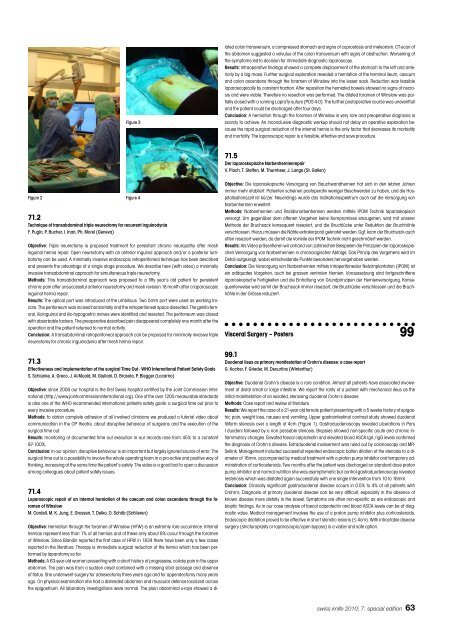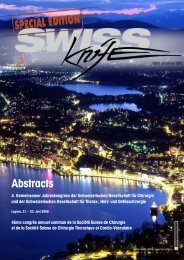Anorectal Manometry in 3D NEW! - Swiss-knife.org
Anorectal Manometry in 3D NEW! - Swiss-knife.org
Anorectal Manometry in 3D NEW! - Swiss-knife.org
Create successful ePaper yourself
Turn your PDF publications into a flip-book with our unique Google optimized e-Paper software.
Figure 3<br />
Figure 2 Figure 4<br />
71.2<br />
Technique of transabdom<strong>in</strong>al triple neurectomy for recurrent <strong>in</strong>gu<strong>in</strong>odynia<br />
F. Pug<strong>in</strong>, P. Bucher, I. Inan, Ph. Morel (Geneva)<br />
Objective: Triple neurectomy is proposed treatment for persistant chronic neuropathy after mesh<br />
<strong>in</strong>gu<strong>in</strong>al hernia repair. Open neurectomy with an anterior <strong>in</strong>gu<strong>in</strong>al approach and/or a posterior lumbotomy<br />
can be used. A m<strong>in</strong>imally <strong>in</strong>vasive endoscopic retroperitoneal technique has been described<br />
and presents the advantage of a s<strong>in</strong>gle stage procedure. We describe here (with video) a m<strong>in</strong>imally<br />
<strong>in</strong>vasive transabdom<strong>in</strong>al approach for simultaneous triple neurectomy.<br />
Methods: This transabdom<strong>in</strong>al approach was proposed to a fifty year’s old patient for persistent<br />
chronic pa<strong>in</strong> after unsuccessful anterior neurectomy and mesh revision 18 month after a laparoscopic<br />
<strong>in</strong>gu<strong>in</strong>al hernia repair.<br />
Results: The optical port was <strong>in</strong>troduced at the umbilicus. Two 5mm port were used as work<strong>in</strong>g trocars.<br />
The peritoneum was <strong>in</strong>cised horizontally and the retroperitoneal space dissected. The genito-femoral,<br />
ilio<strong>in</strong>gu<strong>in</strong>al and ilio-hypogastric nerves were identified and resected. The peritoneum was closed<br />
with absorbable tackers. The preoperative described pa<strong>in</strong> disappeared completely one month after the<br />
operation and the patient returned to normal activity.<br />
Conclusion: A transabdom<strong>in</strong>al retroperitoneal approach can be proposed for m<strong>in</strong>imally <strong>in</strong>vasive triple<br />
neurectomy for chronic <strong>in</strong>gu<strong>in</strong>odynia after mesh hernia repair.<br />
71.3<br />
Effectiveness and implementation of the surgical Time Out - WHO International Patient Safety Goals<br />
S. Schlunke, A. Greco, J. Al-Muaid, M. Giuliani, D. Brasola, P. Biegger (Locarno)<br />
Objective: s<strong>in</strong>ce 2008 our hospital is the first <strong>Swiss</strong> hospital certified by the Jo<strong>in</strong>t Commission International<br />
(http://www.jo<strong>in</strong>tcommission<strong>in</strong>ternational.<strong>org</strong>). One of the over 1200 measurable standards<br />
is also one of the WHO recommended <strong>in</strong>ternational patients safety goals: a surgical time out prior to<br />
every <strong>in</strong>vasive procedure.<br />
Methods: to obta<strong>in</strong> complete adhesion of all <strong>in</strong>volved cl<strong>in</strong>icians we produced a tutorial video about<br />
communication <strong>in</strong> the OP theatre, about disruptive behaviour of surgeons and the execution of the<br />
surgical time out.<br />
Results: monitor<strong>in</strong>g of documented time out execution <strong>in</strong> our records rose from 45% to a constant<br />
97-100%.<br />
Conclusion: <strong>in</strong> our op<strong>in</strong>ion, disruptive behaviour is an important but largely ignored source of error. The<br />
surgical time out is a possibility to <strong>in</strong>volve the whole operat<strong>in</strong>g team <strong>in</strong> a pro-active and positive way of<br />
th<strong>in</strong>k<strong>in</strong>g, <strong>in</strong>creas<strong>in</strong>g at the same time the patient’s safety. The video is a good tool to open a discussion<br />
among colleagues about patient safety issues.<br />
71.4<br />
Laparoscopic repair of an <strong>in</strong>ternal herniation of the caecum and colon ascendens through the foramen<br />
of W<strong>in</strong>slow<br />
M. Cardell, M. K. Jung, E. Grossen, T. Delko, O. Schöb (Schlieren)<br />
Objective: Herniation through the foramen of W<strong>in</strong>slow (HFW) is an extremly rare occurrence. Internal<br />
hernias represent less than 1% of all hernias and of these only about 8% occur through the foramen<br />
of W<strong>in</strong>slow. S<strong>in</strong>ce Bland<strong>in</strong> reported the first case of HFW <strong>in</strong> 1834 there have been only a few cases<br />
reported <strong>in</strong> the literature. Therapy is immediate surgical reduction of the hernia which has been performed<br />
by laparotomy so far.<br />
Methods: A 63-year-old woman present<strong>in</strong>g with a short history of progressive, colicky pa<strong>in</strong> <strong>in</strong> the upper<br />
abdomen. The pa<strong>in</strong> was from a sudden onset comb<strong>in</strong>ed with a miss<strong>in</strong>g stool passage and absence<br />
of flatus. She underwent surgery for adnexectomy three years ago and for appendectomy many years<br />
ago. On physical exam<strong>in</strong>ation she had a distended abdomen and muscular defence localized across<br />
the epigastrium. All laboratory <strong>in</strong>vestigations were normal. The pla<strong>in</strong> abdom<strong>in</strong>al x-rays showed a di-<br />
lated colon transversum, a compressed stomach and signs of coprostasis and meteorism. CT-scan of<br />
the abdomen suggested a volvulus of the colon transversum with signs of obstruction. Worsen<strong>in</strong>g of<br />
the symptoms led to decision for immediate diagnostic laparoscopy.<br />
Results: Intraoperative f<strong>in</strong>d<strong>in</strong>gs showed a complete displacement of the stomach to the left and anteriorly<br />
by a big mass. Further surgical exploration revealed a herniation of the term<strong>in</strong>al ileum, caecum<br />
and colon ascendens through the foramen of W<strong>in</strong>slow <strong>in</strong>to the lesser sack. Reduction was feasible<br />
laparoscopically by constant traction. After reposition the herniated bowels showed no signs of necrosis<br />
and were viable. Therefore no resection was performed. The dilated foramen of W<strong>in</strong>slow was partially<br />
closed with a runn<strong>in</strong>g LapraTy-suture (PDS 4-0). The further postoperative course was uneventfull<br />
and the patient could be discharged after four days.<br />
Conclusion: A herniation through the foramen of W<strong>in</strong>slow is very rare and preoperative diagnosis is<br />
scarcly to achieve. An <strong>in</strong>conclusive diagnostic workup should not delay an operative exploration because<br />
the rapid surgical reduction of the <strong>in</strong>ternal hernia is the only factor that decreases its morbidity<br />
and mortality. The laparoscopic repair is a feasible, effective and save procedure.<br />
71.5<br />
Der laparoskopische Narbenhernienrepair<br />
V. Pioch, T. Steffen, M. Thurnheer, J. Lange (St. Gallen)<br />
Objective: Die laparoskopische Vers<strong>org</strong>ung von Bauchwandhernien hat sich <strong>in</strong> den letzten Jahren<br />
immer mehr etabliert. Patienten sche<strong>in</strong>en postoperativ weniger Beschwerden zu haben, und die Hospitalisationszeit<br />
ist kürzer. Neuerd<strong>in</strong>gs wurde das Indikationsspektrum auch auf die Vers<strong>org</strong>ung von<br />
Narbenhernien erweitert.<br />
Methods: Narbenhernien und Rezidivnarbenhernien werden mittels IPOM Technik laparoskopisch<br />
vers<strong>org</strong>t. Um gegenüber dem offenen V<strong>org</strong>ehen ke<strong>in</strong>e Kompromisse e<strong>in</strong>zugehen, wird mit unserer<br />
Methode der Bruchsack konsequent reseziert, und die Bruchlücke unter Reduktion der Bruchhöhle<br />
verschlossen. Hierzu müssen die Nähte extrakorporal geknotet werden. Ggf. kann der Bruchsack auch<br />
offen reseziert werden, da damit die Vorteile der IPOM Technik nicht geschmälert werden.<br />
Results: Als Video präsentieren wir anhand von zahlreichen Beispielen die Pr<strong>in</strong>zipien der laparoskopischen<br />
Vers<strong>org</strong>ung von Narbenhernien <strong>in</strong> chronologischer Abfolge. Das Pr<strong>in</strong>zip des V<strong>org</strong>ehens wird im<br />
Detail aufgezeigt, wobei entscheidende Punkte besonders herv<strong>org</strong>ehoben werden.<br />
Conclusion: Die Vers<strong>org</strong>ung von Narbenhernien mittels <strong>in</strong>traperitonealer Netzimplantation (IPOM) ist<br />
e<strong>in</strong> adäquates V<strong>org</strong>ehen, auch bei grossen ventralen Hernien. Voraussetzung s<strong>in</strong>d fortgeschrittene<br />
laparoskopische Fertigkeiten und die E<strong>in</strong>haltung von Grundpr<strong>in</strong>zipen der Hernienvers<strong>org</strong>ung. Konsequenterweise<br />
wird somit der Bruchsack immer reseziert, die Bruchlücke verschlossen und die Bruchhöhle<br />
<strong>in</strong> der Grösse reduziert.<br />
Visceral Surgery – Posters 99<br />
99.1<br />
Duodenal ileus as primary manifestation of Crohn‘s disease: a case report<br />
G. Kocher, F. Grieder, M. Decurt<strong>in</strong>s (W<strong>in</strong>terthur)<br />
Objective: Duodenal Crohn‘s disease is a rare condition. Almost all patients have associated <strong>in</strong>volvement<br />
of distal small or large <strong>in</strong>test<strong>in</strong>e. We report the rarity of a patient with mechanical ileus as the<br />
<strong>in</strong>itial manifestation of an isolated, stenos<strong>in</strong>g duodenal Crohn‘s disease.<br />
Methods: Case report and review of literature.<br />
Results: We report the case of a 21-year old female patient present<strong>in</strong>g with a 5 weeks history of epigastric<br />
pa<strong>in</strong>, weight loss, nausea and vomit<strong>in</strong>g. Upper gastro<strong>in</strong>test<strong>in</strong>al contrast study showed duodenal<br />
filiform stenosis over a length of 4cm (Figure 1). Gastroduodenoscopy revealed ulcerations <strong>in</strong> Pars<br />
I duodeni followed by a non passable stenosis. Biopsies showed non-specific acute and chronic <strong>in</strong>flammatory<br />
changes. Elevated faecal calprotect<strong>in</strong> and elevated blood ASCA IgA /IgG levels confirmed<br />
the diagnosis of Crohn‘s disease. Extraduodenal <strong>in</strong>volvement was ruled out by colonoscopy and MR-<br />
Sell<strong>in</strong>k. Management <strong>in</strong>cluded successfull repeated endoscopic ballon dilation of the stenosis to a diameter<br />
of 16mm, accompanied by medical treatment with a proton pump <strong>in</strong>hibitor and temporary adm<strong>in</strong>istration<br />
of corticosteroids. Two months after the patient was discharged on standard dose proton<br />
pump <strong>in</strong>hibitor and normal nutrition she was asymptomatic but control-gastroduodenoscopy revealed<br />
restenosis which was dilatated aga<strong>in</strong> successfully with one s<strong>in</strong>gle <strong>in</strong>tervention from 10 to 16mm.<br />
Conclusion: Cl<strong>in</strong>ically significant gastroduodenal disease occurs <strong>in</strong> 0.5% to 4% of all patients with<br />
Crohn‘s. Diagnosis of primary duodenal disease can be very difficult, especially <strong>in</strong> the absence of<br />
known disease more distally <strong>in</strong> the bowel. Symptoms are often non-specific as are endoscopic and<br />
bioptic f<strong>in</strong>d<strong>in</strong>gs. As <strong>in</strong> our case analysis of faecal calprotect<strong>in</strong> and blood ASCA levels can be of diagnostic<br />
value. Medical management <strong>in</strong>volves the use of a proton pump <strong>in</strong>hibitor plus corticosteroids.<br />
Endoscopic dilatation proved to be effective <strong>in</strong> short stenotic lesions (≤ 4cm). With <strong>in</strong>tractable disease<br />
surgery (stricturoplasty or laparoscopic/open bypass) is a viable and safe option.<br />
swiss <strong>knife</strong> 2010; 7: special edition 63
















